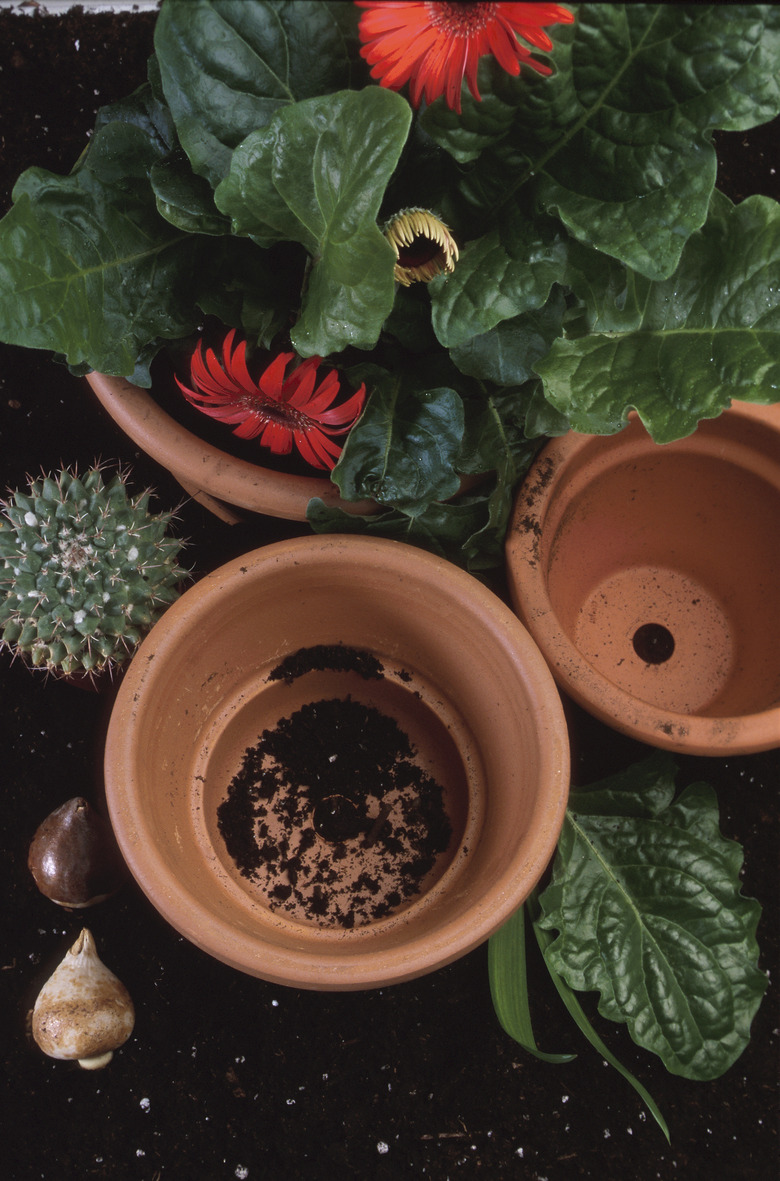How To Use Bleach As Garden Fungicide
It's just plain silly to throw away perfectly good planting pots and containers at the end of the season when it's so easy to save and reuse them indefinitely. It's also easy to inadvertently recycle last year's garden fungi. One of the most common fungal diseases that remain persistently on pots from year to year causes the much-feared seedling killer, damping off. Even if the containers look clean, you can't see fungal spores with the naked eye. Look no further than your laundry room for a powerful disinfecting agent to use as a garden fungicide. All it takes is a little time and some bleach to recycle your containers and protect your plants from often-fatal pathogens on the cheap.
Disinfecting Non-porous Items
Step 1
Step 1
Scour non-porous garden pots, containers, flats and tools with a stiff scrub brush. Use hot tap water and liquid Castile soap or non-degreasing dish soap. Rinse thoroughly with hot water. A good cleaning is necessary because even though bleach is strong stuff, it can't penetrate dirt and debris.
- It's just plain silly to throw away perfectly good planting pots and containers at the end of the season when It's so easy to save and reuse them indefinitely.
- All it takes is a little time and some bleach to recycle your containers and protect your plants from often-fatal pathogens on the cheap.
Step 2
Step 2
Funnel 1 1/2 cups household bleach into a clean plastic 1-gallon milk jug to create an effective 1-to-9 garden fungicide. Mark the bleach level on the jug with a permanent marker so you won't have to slow down to measure the next time you make the solution. You'll get the best results if you mix a new batch each time you need garden fungicide.
Step 3
Step 3
Top off the jug with cold tap water. Cap it securely, and shake to combine the ingredients thoroughly. Label the jug clearly.
Step 4
Step 4
Soak non-porous gardening items in the bleach solution for at least 10 minutes. Wash well with non-degreasing dish soap or liquid Castile soap. Rinse with hot water.
- Funnel 1 1/2 cups household bleach into a clean plastic 1-gallon milk jug to create an effective 1-to-9 garden fungicide.
- You'll get the best results if you mix a new batch each time you need garden fungicide.
Step 5
Step 5
Apply a light coat of all-purpose oil to dry, disinfected tools to prevent them from rusting.
DIsinfecting Terra Cotta Containers
Step 1
Step 1
Scrub terra cotta containers with a wire brush or scouring pad in hot water and liquid Castile or non-degreasing dish soap to remove fungal spores as well as salt and mineral deposits. If stubborn spots remain, scrape them off with a knife.
Step 2
Step 2
Set the containers in a bucket. Cover them completely with a 1-to-9 bleach solution. Allow them to soak 10 to 15 minutes.
Step 3
Step 3
Wash the containers with soap and hot water. Rinse thoroughly with hot water.
- Apply a light coat of all-purpose oil to dry, disinfected tools to prevent them from rusting.
Step 4
Step 4
Put the containers in a bucket, and cover them with cool, clean water. Keep them there until you're ready to use them. This hydrates the porous material so that it won't wick water away from your plants.
Pruning
Step 1
Step 1
Fill a plastic spray bottle with a 1-to-9 bleach mixture when you prune or deadhead.
Step 2
Step 2
Make all your cuts with clean, sharp shears.
Step 3
Step 3
Spritz your tool with bleach mixture when you're through trimming the first plant. Coat all surfaces thoroughly to the point of runoff.
- Put the containers in a bucket, and cover them with cool, clean water.
- Spritz your tool with bleach mixture when you're through trimming the first plant.
Step 4
Step 4
Wipe the liquid off the tool with a clean, soft cloth before moving to the next plant. This prevents the possibility of spreading undetected fungus and other pathogens from one plant to another.
Step 5
Step 5
Pick up and destroy all trimmings right away. Pests and diseases are attracted to your garden by decaying vegetation. Don't toss them onto the compost heap.
Tip
While you may worry that bleach is a serious chemical, it might make you feel better to know that even organic gardeners swear by the material for fighting garden fungi.
Tip
If you know that you've got an infectious organism infiltrating your garden, increase the bleach ratio to 5 parts water and 1 part bleach.
Warning
Never mix bleach with any other cleaner. The resulting poison can seriously harm or even kill you. Mixing bleach with vinegar or ammonia releases highly toxic chlorine gases.
Things Needed
- Stiff scrub brush
- Liquid Castile soap or non-degreasing dish soap
- Funnel
- Measuring cups
- Household bleach
- Clean plastic 1-gallon milk jug
- Permanent marker
- All-purpose oil
- Wire brush or scouring pad
- Knife
- Buckets
- Clean, sharp shears
- Plastic spray bottle
- Clean, soft cloth
References
- The Organic Gardener's Handbook of Natural Insect and Disease Control: Bleach
- Philadelphia County Master Gardeners: Why Sanitize? Spring Cleaning Your Containers
- UC IPM Online: Management of Soilborne Pathogens
- Ask the Exterminator: What Is Bleach?
- University of Vermont Extension: Control of Ornamental Diseases
- Yardener: Dealing With Fungal Disease
- Clemson Cooperative Extension: Rose Diseases
- Iowa State University Extension: Cleaning and Disinfecting Plant Containers
- Tom Clothier: Damping Off
